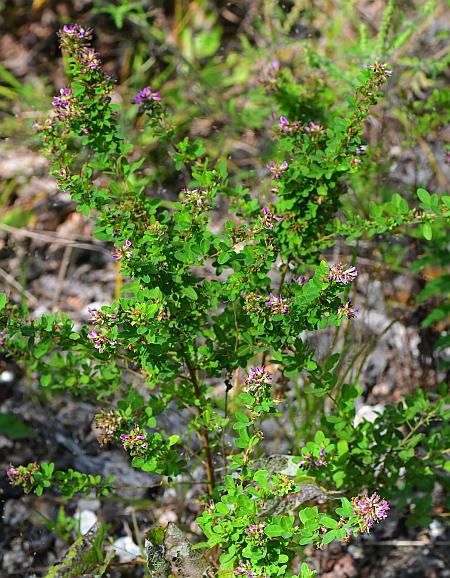Lespedeza violacea (L.) Pers.
Violet Lespedeza

Native
CC = 6
CW = 5
MOC = 52
© SRTurner
Lespedeza violacea (L.) Pers.Violet Lespedeza | |
 |
Native CC = 6 CW = 5 MOC = 52 |
© SRTurner |
|
Family - Fabaceae/Faboideae Habit - Perennial forb. Stem - Ascending to erect, to 1 m, 1-4 mm in diameter near the base, unbranched or branched only above the midpoint, sparsely to occasionally densely pubescent with relatively inconspicuous, appressed hairs, rarely nearly glabrous at maturity.
Leaves - Alternate, trifoliate, petiolate, stipulate. Primary median leaves with the petiole most commonly relatively long and slender, 4-25 mm long, sparsely to densely appressed-to loosely appressed-hairy. Stipules 2-4 mm long, linear to hairlike. Leaflets 8-30 mm long, 3-17 mm wide (1.5-3.0 times as long as wide), broadly oblong to elliptic or obovate, those of the uppermost leaves sometimes oblanceolate, rounded to angled at the base, rounded to nearly truncate at the tip, the midvein usually extended as a minute, sharp point at the very tip, the upper surface glabrous or sparsely appressed-hairy near the midvein, the undersurface sparsely to moderately or occasionally densely appressed-hairy. Axillary leaves absent or poorly developed at some nodes.
Inflorescences - Axillary clusters from the upper leaves, often appearing axillary and terminal on short branches toward the main stem tip (the cleistogamous flowers generally appearing in short, dense, axillary clusters), usually unbranched, sometimes appearing leafy, shorter than or only slightly exceeding the leaves. Flowers mostly 4-10 per raceme.
Flowers - Calyces with the tube 1.5-2.0 mm long, the lobes 2-3 mm long. Corollas papilionaceous, 5-7 mm long, pinkish purple, the banner usually darker purple toward the base, the keel sometimes darker purple at the tip, distinctly shorter than the wings.
Flowering - June - October. Habitat - Forest openings, glades, savannas, tops of bluffs, upland prairies, fields, roadsides. Origin - Native to the U.S. Lookalikes - L. frutescens, L. virginica. Other info. - This species of Lespedeza is found across much of Missouri but is apparently absent from the northwestern quadrant of the state. Beyond Missouri its range includes much of the eastern U.S. and Canada. The plant is recognized by clusters of small purplish flowers having the bean family motif, trifoliate compound leaves which are not very narrow, and stem pubescence which is flat and inconspicuous. A potential lookalike is L. frutescens, but that plant is usually less erect, and the flowers have keel petals which generally exceed the wing petals. In L. violacea the keels are shorter than the wings, as can be clearly seen in one of the flower images above. Photographs taken near Loda Lake, Newaygo County, MI, 8-27-2020 and 8-11-2022, and at Pea Ridge Conservation Area, Washington County, MO, 9-18-2020 (SRTurner). |